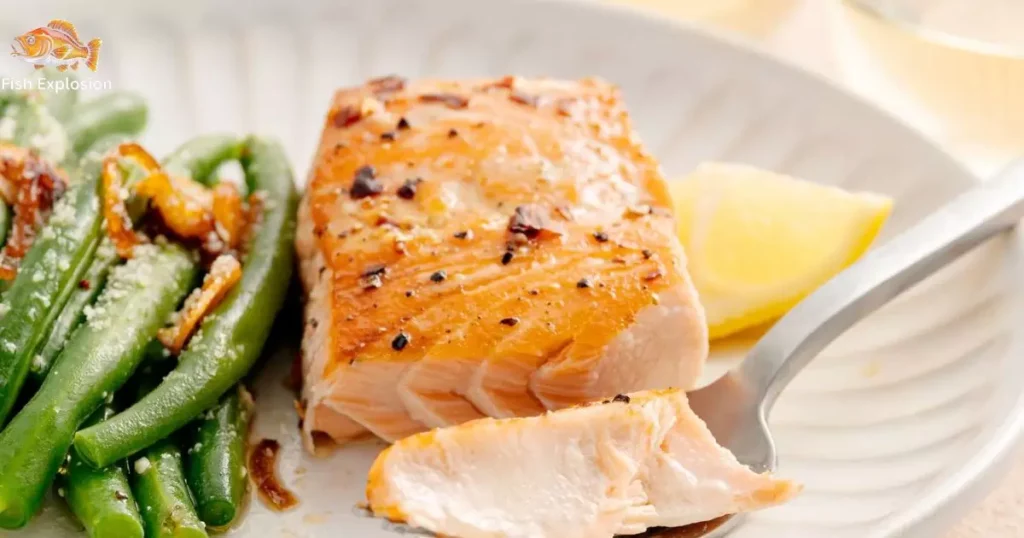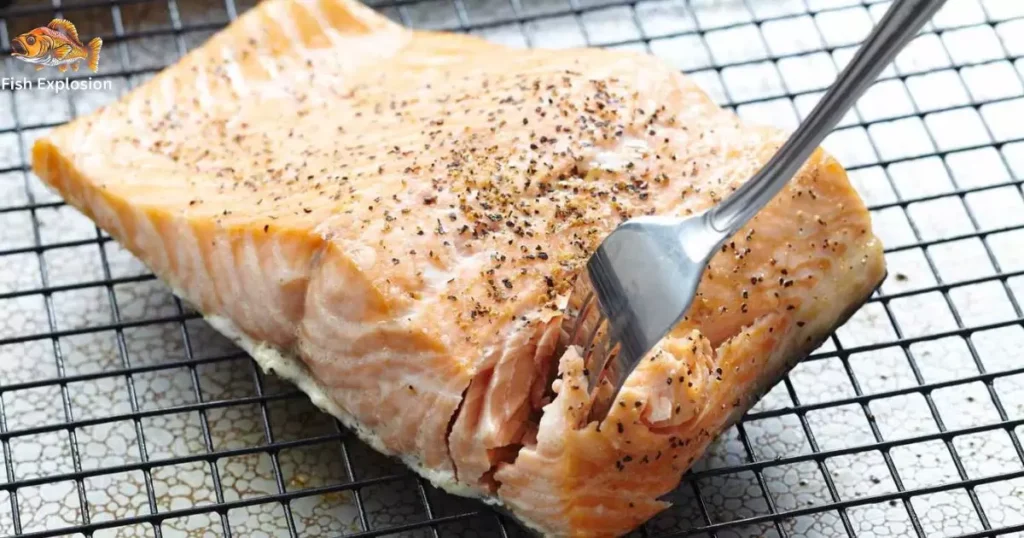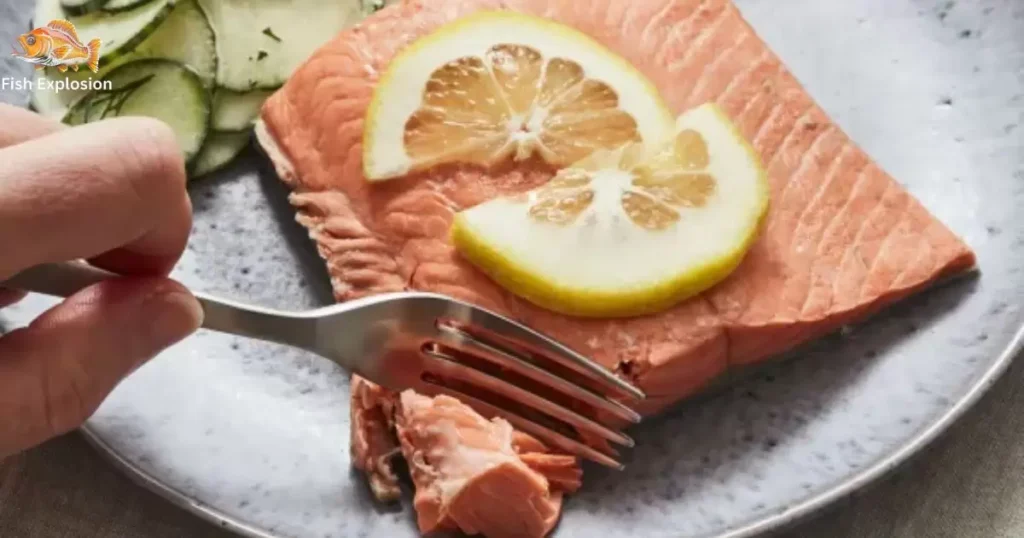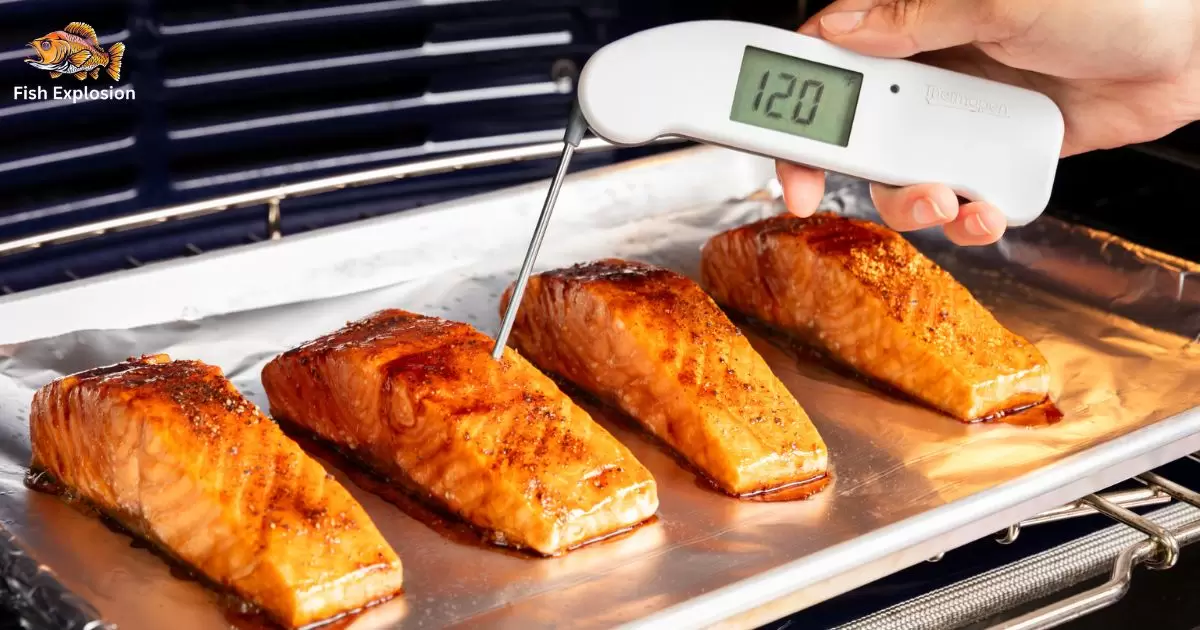Cooking salmon to perfection, achieving a tender, flaky texture and mouthwatering flavor, requires a delicate balance of time and temperature.
This comprehensive guide will unlock the secrets to the ideal temperature ranges for various cooking methods, equipping you with the knowledge to consistently recreate restaurant-quality salmon dishes in the comfort of your own home kitchen. Whether you prefer your salmon with a moist, delicate consistency or a slightly firmer texture, understanding the nuances of temperature is key.
From baking and grilling to pan-searing, we’ll explore the recommended temperature windows to unlock the full potential of this rich, fatty fish. Additionally, you’ll gain insights into the importance of using an accurate thermometer, food safety principles, and expert tips for foolproof results every time you prepare this beloved seafood delicacy.
Read More: “10 Best White Fish To Eat According To Chefs”
What is the Proper Temperature for Cooking Salmon?

The proper temperature for cooking salmon depends on the desired cooked level and the cooking method used. For food safety reasons, the FDA recommends cooking salmon to an internal temperature of 145°F (63°C) to kill any potential harmful bacteria.
However, many chefs and home cooks prefer their salmon a bit more on the rare side, typically aiming for an internal temperature between 120°F (49°C) and 125°F (52°C) for a moist, tender, and flaky texture. When grilling, baking, or pan-searing salmon, monitoring the internal temperature with an instant-read thermometer is crucial to achieving your desired doneness.
It’s important to note that the temperature will continue to rise slightly after removing the salmon from the heat source, so it’s best to remove it from the heat a few degrees before reaching your target temperature.
Salmon Temperature Guide By Doneness
In mastering the art of cooking salmon, achieving the perfect doneness is paramount. Each temperature range offers a distinct texture and flavor profile, ensuring a culinary delight for every preference.
From the delicate translucence of rare to the hearty firmness of well-done, the spectrum of possibilities tantalizes the taste buds, promising a delectable experience with every bite.
| Doneness | Temperature Range | Description |
|---|---|---|
| Rare | 110-115°F | The flesh remains translucent and slightly soft, yet not recommended for safety reasons due to its undercooked nature. |
| Medium rare | 115-120°F | As the flesh begins to turn opaque, it retains a soft and moist texture, offering a delightful balance of tenderness and flavor. |
| Medium | 120-125°F | With a fully opaque flesh and a slight firmness to the touch, this stage presents the quintessential salmon experience, enhanced by a pinkish center. |
| Medium well | 125-140°F | Transitioning into a firmer texture, the light pink center of the salmon denotes its progression towards a heartier doneness, satisfying even the most discerning palate. |
| Well done | 140-150°F | Fully cooked with no trace of pink, the firmness of the flesh signifies a robust culmination of flavors, ideal for those who prefer a thoroughly cooked salmon. |
Kyle’s Tips to Avoid Overcooking Salmon

Maintaining the delicate texture and flavor of salmon depends on avoiding overcooking. Salmon that is cooked beyond its peak point can rapidly become dry, tough, and unappetizing, robbing you of the rich, moist experience you desire.
Fortunately, by following a few simple tips, you can reliably achieve perfectly cooked salmon that satisfies your cravings every time.
Using a Reliable Thermometer
Investing in a high-quality, instant-read thermometer is one of the most effective ways to prevent overcooking. By monitoring the internal temperature of your salmon, you can remove it from the heat source at the precise moment it reaches your desired doneness level.
Let It Rest
After removing your salmon from the heat source, it’s important to let it rest for a few minutes. This resting period allows the residual heat to gently finish cooking the salmon, ensuring it’s cooked through without becoming overdone.
Know Your Cooking Method
Different cooking methods, such as baking, grilling, or pan-searing, can affect the cooking time and temperature. Familiarize yourself with the nuances of each method to better gauge the appropriate cooking time and temperature for your desired doneness level.
Check for Doneness Early
The thin line between perfectly cooked and overdone salmon can be crossed within minutes. To safeguard against overcooking, begin checking for doneness several minutes prior to the estimated cooking time.
This proactive approach allows you to swiftly remove the salmon from the heat source the moment it attains your desired internal temperature, preserving its optimal texture and flavor.
Consider the Thickness
The thickness of your salmon fillets or steaks can significantly impact cooking times. Thicker cuts will require more time to cook through, while thinner pieces will cook faster. Adjust your cooking time and temperature accordingly.
Use the Right Pan or Dish
The type of pan or dish you use can also affect cooking times. For example, dark-colored pans tend to cook faster than light-colored ones, so you may need to adjust your temperature or cooking time accordingly.
Pay Attention to Residual Heat
Even after removing your salmon from the heat source, it will continue to cook slightly due to residual heat. This carryover cooking can easily lead to overcooking if you’re not mindful of it.
Embrace a Slightly Undercooked Center
For many salmon enthusiasts, a slightly undercooked center is the key to achieving a moist, tender, and flavorful result. If you’re aiming for a medium-rare to medium doneness level, it’s perfectly acceptable to have a slightly translucent center when you remove the salmon from the heat source.
Can I eat salmon at 140 degrees?

Consuming salmon at an internal temperature of 140°F (60°C) is generally considered safe, as this temperature falls within the range recommended by food safety authorities. However, at this doneness level, the salmon will be well-done, with a firm texture and no remaining pinkness or translucency in the flesh.
While some prefer their salmon cooked to this degree, many find it to be overcooked, resulting in a drier, less moist and flavorful experience.
For optimal taste and texture, most culinary experts suggest cooking salmon to an internal temperature between 120°F (49°C) and 125°F (52°C) for a medium doneness.
Cooking salmon temperature guide oven
When baking salmon in the oven, aim for an internal temperature of 120°F (49°C) to 125°F (52°C) for a moist, flaky texture with a slightly translucent center. For a firmer texture throughout, cook until the internal temperature reaches 130°F (54°C) to 135°F (57°C).
Keep in mind that the salmon’s temperature will continue to rise slightly after removing it from the oven, so factor in this carryover cooking when determining your target temperature.
FAQ’s
What is the correct temperature for cooked salmon?
The correct internal temperature for cooked salmon is 145°F (63°C).
What temperature should fish be cooked to Celsius?
Fish should generally be cooked to an internal temperature of 145°F (63°C).
What temperature to cook salmon on the stove?
When cooking salmon on the stove, aim for a medium heat to gently cook the fish through.
Can you eat salmon raw?
Yes, you can eat salmon raw if it is fresh, properly handled, and specifically prepared for raw consumption.
Conclusion
Cooking salmon properly involves achieving the right internal temperature to ensure both safety and the desired doneness. The FDA recommends cooking salmon to an internal temperature of 145°F (63°C) to eliminate harmful bacteria. However, for a more tender and flavorful experience, many cooks prefer an internal temperature ranging from 120°F (49°C) to 125°F (52°C).
It’s important to use an instant-read thermometer to monitor the temperature closely and remove the salmon slightly before it reaches the desired temperature to account for carryover cooking. This method not only ensures safety but also preserves the salmon’s delicate texture and moisture.
Depending on personal preference, salmon can be enjoyed from rare to well-done, each providing a unique texture and taste, making it essential to understand the nuances of various cooking temperatures and methods.
With three years of dedicated expertise in the niche of fish, my domain knowledge encompasses breeding, habitat maintenance, health management, and sustainable aquaculture practices, ensuring optimal outcomes in the aquatic realm.











